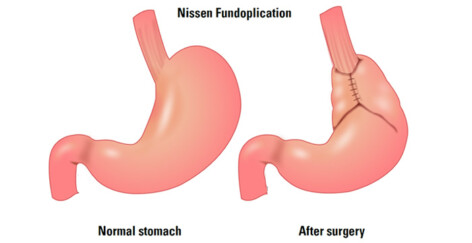Laparoscopic Acid Reflux Surgery
What is Nissen Fundoplication?

Nissen Fundoplication, commonly referred to as acid reflux or GERD surgery, can successfully treat GERD by correcting the problem at its root cause. It involves reinforcing the lower esophageal sphincter (LES) by wrapping the upper portion of the stomach around the lowest portion of the esophagus. The most common reason for this type of surgery is the inability to get relief from acid reflux with medications and lifestyle changes. Nissen Fundoplication is a standard operative treatment in select patients with gastroesophageal reflux disease.
Benefits of Laparoscopic Nissen Fundoplication
This surgery has a high rate of success for patients over the long-term. Reinforcing the lower esophageal sphincter reduces the chance that acid will back up in the esophagus which will stop the pain from acid reflux and you’re less likely to need to use medications to treat heartburn. You’re also less likely to develop other complications caused by acid in the esophagus, such as esophageal cancer.
Because this is a laparoscopic surgery there are only a few small incisions required which shortens recovery time compared to open surgery.
How is Laparoscopic Acid Reflux Surgery Performed?
The Nissen fundoplication procedure is done laparoscopically under general anesthesia. Most patients go home after a short overnight stay in the hospital or surgery center.
In a laparoscopic procedure, Dr. Howard will use a quarter inch incisions to enter the abdomen using cannulas (small tube-like instruments). The abdomen is infrared using a harmless gas into the abdominal cavity to expand the viewing area. The laparoscope, which is connected to a video camera, is then inserted through the small incision, giving Dr. Howard, an enlarged view of your internal organs on a screen.
With the images from the laparoscope, Dr. Howard will wrap the upper part of the stomach, called the fundus, around the lower esophagus to create a "valve," and then stitch it in place. This is sometimes referred to as a Nissen 360-degree wrap. Once in place, the instruments are removed and the gas is released. Dr. Howard will close the incisions and cover them with small bandages. This entire procedure usually takes less than an hour.
As with any procedure, it's possible for complications to happen. However, this is uncommon. Possible complications associated with acid reflux surgery can include:
- Infection at the surgical site
- Surgical injury to blood vessels, stomach, or esophagus
- Difficulty swallowing (dysphagia)
- Gas build-up in your stomach
- Infection in your abdomen (peritonitis)
- Repeat surgery if the new valve weakens, loosens, or tears
What to Expect After Acid Reflux Surgery
After surgery, Dr. Howard will give you guidelines to follow. Standard post-operative instructions following laparoscopy include the following:
- No strenuous activities or heavy lifting for the first couple of weeks. Light exercise only. Within a short period of time, you will be able to resume regular activities such as showering, driving, walking up stairs, lifting, working, and engaging in sexual intercourse.
- Take pain medications only as needed. In general, pain after this surgery tends to be mild.
- A postoperative diet will be given to you where you will gradually progress from liquids back to solid foods.
- Schedule a follow-up appointment within 2 weeks after your surgery.
For an in-depth discussion regarding laparoscopic Nissen Fundoplication or to schedule an appointment with Dr. Howard, contact us today.
Learn more about acid reflux and the surgeries that may be able to give you relief.